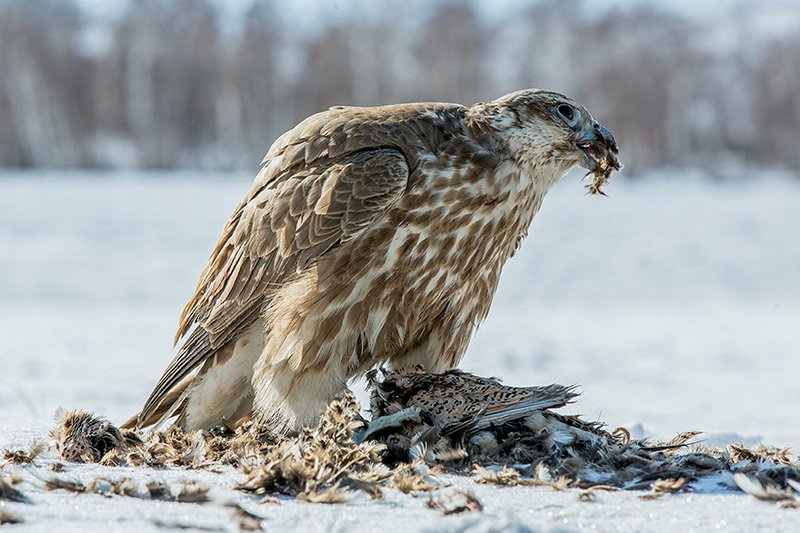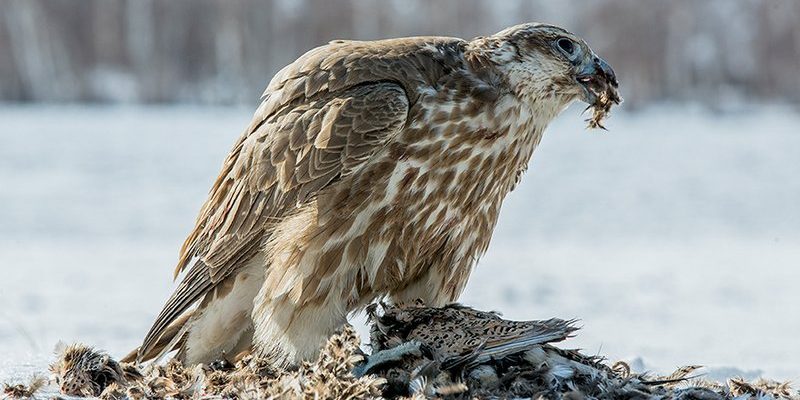
The Saker Falcon is a medium to large-sized falcon, known for its incredible speed and strength. Imagine being able to spot your dinner from a mile away and swoop in with lightning-fast precision. That’s the life of a Saker Falcon! They primarily thrive in open landscapes like steppes and deserts, where they can spot their prey easily. Like a skilled tactician, they use their environment to their advantage, ensuring that they are always on the hunt.
Curious about what makes this bird such a proficient hunter? Let’s break down the Saker Falcon’s diet, its hunting strategies, and why understanding these aspects is essential.
Diet of the Saker Falcon
You might be wondering, “What exactly does a Saker Falcon eat?” Well, these birds have quite the diverse diet. They primarily feast on small to medium-sized birds, but their menu can include:
- Small mammals, like rabbits and hares
- Insects, particularly during warmer months
- Other small creatures, such as lizards and even snakes
Their preference for birds, especially during migration seasons, allows Saker Falcons to capitalize on the abundance of food. It’s like having a buffet every fall and spring! When the birds migrate, the Saker Falcons are right there, ready to snatch up whatever flies by. Honestly, it’s a smart move in the animal kingdom, where every meal counts.
Most often, they target birds that are about the size of a pigeon or smaller. Think of them as the ultimate bird catchers. Using their keen eyesight, they can spot a potential meal from afar, often perching high on a tree or cliff to get the best view.
Hunting Techniques of the Saker Falcon
Now, how does the Saker Falcon actually catch its food? It relies on a mix of speed, stealth, and power. Picture this: a Saker Falcon perched silently on a high branch, scanning the ground below. It’s like a furry little statue, waiting for the perfect moment to strike. When the time is right, the falcon launches itself into the air with incredible speed, reaching up to 150 miles per hour during a dive. That’s like a sports car zooming along the highway!
One common technique is called the stoop. During a stoop, they drop from a height and dive at their prey with astonishing swiftness. This method makes it incredibly difficult for their targets to escape. Imagine you’re playing a game of tag, and someone suddenly dives towards you at lightning speed; it’s hard to avoid them, right?
Plus, Saker Falcons can also practice surprise attacks. They might hide behind rocks or other natural cover, waiting for an unsuspecting bird to come too close. This element of surprise can be a game-changer. If you can catch your dinner off guard, you’ve already won half the battle!
Foraging Habits of the Saker Falcon
While hunting is thrilling, Saker Falcons are also skilled foragers. Instead of relying solely on their hunting prowess, they often take advantage of the food available in their environment. During certain seasons, their diets might shift based on what’s most accessible.
For instance, when small mammals are scarce, they might switch to insects or other smaller prey. It’s a flexible diet tailored to changing circumstances. Like a savvy diner who knows how to adapt their order based on the restaurant’s daily specials, Saker Falcons are experts at using the resources around them.
They also can scavenge from carcasses left behind by other predators. Picture a Saker Falcon swooping down to pick at the leftovers, making the most of every meal. This adaptable behavior not only helps them survive but thrive in various environments.
Impact of Environment on Their Hunting and Foraging
The Saker Falcon’s hunting and foraging behaviors are significantly influenced by their environment. For example, they primarily inhabit open plains and grasslands, which provide ample opportunities to spot their prey from a distance. Think of it like a wide-open stage, where they can swoop in and show off their skills.
In areas where there’s a lot of human activity or agricultural land, these falcons have learned to adapt. They might change their hunting times or move to less disturbed areas to find food. This kind of flexibility is crucial for survival. If they can navigate the challenges of a changing landscape, they stand a better chance of thriving.
Weather also plays a critical role. During harsh winters, prey might be harder to come by, pushing Saker Falcons to forage more extensively or even migrate themselves to find better food sources. It’s like moving to a different city to find a job; they’re constantly on the lookout for the best opportunities!
Challenges Faced by the Saker Falcon
Despite their impressive skills, Saker Falcons face numerous challenges. One major issue is habitat loss due to agricultural expansion and urban development. When their natural homes disappear, so do their hunting grounds. This can lead to decreased food availability and increased competition with other predators.
Additionally, climate change can alter their habitats and food sources. You might think of it as being in a favorite restaurant that suddenly changes its menu or closes down; it’s frustrating and limits your choices. As the environment shifts, these falcons need to adapt quickly to survive, which can be tough.
Moreover, human interference, such as hunting and trapping, poses a direct threat. Conservation efforts are critical to ensure that the Saker Falcon populations remain stable. By protecting their habitats and encouraging sustainable practices, we can help keep these incredible birds soaring in the sky.
The Role of Saker Falcons in the Ecosystem
Understanding what Saker Falcons eat and how they hunt isn’t just interesting; it also highlights their role in the ecosystem. As predators, they help control populations of birds and small mammals, which keeps the balance in nature. Imagine a scale: if there are too many rabbits, they can overgraze on plants, leading to ecological damage. Saker Falcons help maintain that equilibrium by preying on these populations.
Furthermore, they are a vital part of the food web. Other predators, including larger birds and mammals, can rely on Saker Falcons as a food source when they themselves are in need. The connections they create within the ecosystem illustrate the complexity of nature and how every creature plays a part.
By understanding their place in the ecosystem, we can advocate for conservation efforts that protect their habitats and promote biodiversity. In a way, it helps us appreciate the intricate dance of life unfolding around us.
In summary, the Saker Falcon is an incredible creature with a diverse diet and impressive hunting techniques. Whether it’s capturing small birds mid-flight or foraging in changing environments, this bird showcases the beauty and adaptability of nature. As we continue to learn about their behaviors and challenges, we can support efforts to protect them and their ecosystems.
So the next time you hear about falcons or see one soaring overhead, remember the fascinating world of the Saker Falcon and its vital role in maintaining the balance of nature. Every meal they catch is part of a larger story that connects us all.

